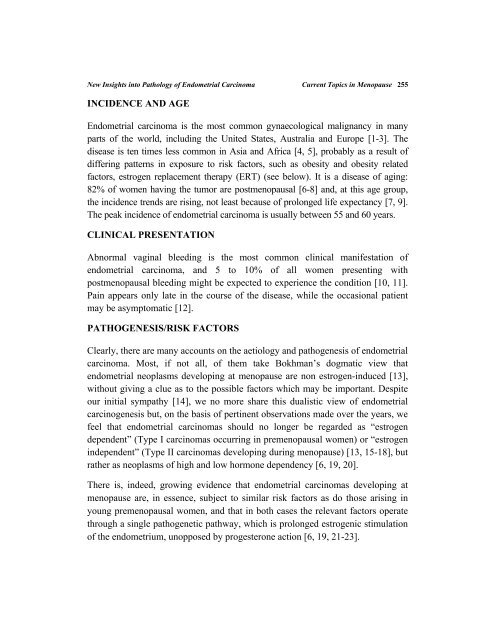Download - Bentham Science
Download - Bentham Science
Download - Bentham Science
You also want an ePaper? Increase the reach of your titles
YUMPU automatically turns print PDFs into web optimized ePapers that Google loves.
New Insights into Pathology of Endometrial Carcinoma Current Topics in Menopause 255<br />
INCIDENCE AND AGE<br />
Endometrial carcinoma is the most common gynaecological malignancy in many<br />
parts of the world, including the United States, Australia and Europe [1-3]. The<br />
disease is ten times less common in Asia and Africa [4, 5], probably as a result of<br />
differing patterns in exposure to risk factors, such as obesity and obesity related<br />
factors, estrogen replacement therapy (ERT) (see below). It is a disease of aging:<br />
82% of women having the tumor are postmenopausal [6-8] and, at this age group,<br />
the incidence trends are rising, not least because of prolonged life expectancy [7, 9].<br />
The peak incidence of endometrial carcinoma is usually between 55 and 60 years.<br />
CLINICAL PRESENTATION<br />
Abnormal vaginal bleeding is the most common clinical manifestation of<br />
endometrial carcinoma, and 5 to 10% of all women presenting with<br />
postmenopausal bleeding might be expected to experience the condition [10, 11].<br />
Pain appears only late in the course of the disease, while the occasional patient<br />
may be asymptomatic [12].<br />
PATHOGENESIS/RISK FACTORS<br />
Clearly, there are many accounts on the aetiology and pathogenesis of endometrial<br />
carcinoma. Most, if not all, of them take Bokhman’s dogmatic view that<br />
endometrial neoplasms developing at menopause are non estrogen-induced [13],<br />
without giving a clue as to the possible factors which may be important. Despite<br />
our initial sympathy [14], we no more share this dualistic view of endometrial<br />
carcinogenesis but, on the basis of pertinent observations made over the years, we<br />
feel that endometrial carcinomas should no longer be regarded as “estrogen<br />
dependent” (Type I carcinomas occurring in premenopausal women) or “estrogen<br />
independent” (Type II carcinomas developing during menopause) [13, 15-18], but<br />
rather as neoplasms of high and low hormone dependency [6, 19, 20].<br />
There is, indeed, growing evidence that endometrial carcinomas developing at<br />
menopause are, in essence, subject to similar risk factors as do those arising in<br />
young premenopausal women, and that in both cases the relevant factors operate<br />
through a single pathogenetic pathway, which is prolonged estrogenic stimulation<br />
of the endometrium, unopposed by progesterone action [6, 19, 21-23].
















